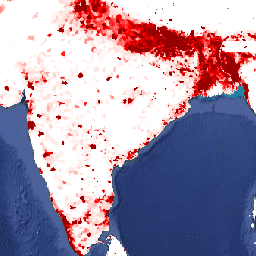Page Summary
-
This dataset provides modeled global human population distribution for 2000, 2005, 2010, 2015, and 2020 at approximately 1 km resolution.
-
Population estimates are based on census and administrative data, adjusted to match UN World Population Prospects country totals for 2015.
-
The dataset contains population density grids showing persons per square kilometer.
-
This specific dataset has been superseded by CIESIN/GPWv411/GPW_UNWPP-Adjusted_Population_Density.

- Dataset Availability
- 2000-01-01T00:00:00Z–2020-01-01T00:00:00Z
- Dataset Provider
- CIESIN
- Cadence
- 5 Years
- Tags
Description
The Gridded Population of World Version 4 (GPWv4) models the distribution of global human population for the years 2000, 2005, 2010, 2015, and 2020 on 30 arc-second (approximately 1 km) grid cells. Population is distributed to cells using proportional allocation of population from census and administrative units. Population input data are collected at the most detailed spatial resolution available from the results of the 2010 round of censuses, which occurred between 2005 and 2014. The input data are extrapolated to produce population estimates for each modeled year.
These population density grids contain estimates of the number of persons per 30 arc-second grid cell, consistent with national censuses and population registers with respect to relative spatial distribution but adjusted to match the 2015 Revision of UN World Population Prospects country totals. There is one image for each modeled year.
Bands
Pixel Size
927.67 meters
Bands
| Name | Min | Max | Pixel Size | Description |
|---|---|---|---|---|
population-density |
0* | 3.83667e+06* | meters | The estimated number of persons per square kilometer. |
Terms of Use
Terms of Use
Citations
Center for International Earth Science Information Network - CIESIN - Columbia University. 2016. Gridded Population of the World, Version 4 (GPWv4): Population Density Adjusted to Match 2015 Revision of UN WPP Country Totals. Palisades, NY: NASA Socioeconomic Data and Applications Center (SEDAC). https://doi.org/10.7927/H4HX19NJ. Accessed DAY MONTH YEAR.
DOIs
Explore with Earth Engine
Code Editor (JavaScript)
var dataset = ee.ImageCollection('CIESIN/GPWv4/unwpp-adjusted-population-density'); var populationDensity = dataset.select('population-density') .filter(ee.Filter.date('2010-01-01', '2010-12-31')); var populationDensityVis = { min: 200.0, max: 1500.0, palette: ['ffffff', 'ffcdc6', 'ff0000', '950000'], }; Map.setCenter(79.1, 19.81, 3); Map.addLayer(populationDensity, populationDensityVis, 'Population Density');